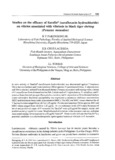Microbial procedure: Vibrio parahaemolyticus
Share
abstrak
Food poisoning due to Vibrio parahaemolyticus is afood-borne infection resulting from the ingestion of alarge number of this organism (about 106-109 viable cells). The major symptoms are diarrhea and abdominal pain with headache, fever, and vomiting also occurring. The organisms are excreted during the acute stage of the illness after which they decrease rapidly.The differentiation of V. parahaemolyticus from other pathogenic species of Vibrio is based mainly on salt tolerance, Voges-Proskauer reaction, fermentation of sucrose, and growth at 43°C. Presented in the paper is the methodology of determining the presence of Vibrio cholera in fish and fishery products.
Suggested Citation
Lim, P. Y. (1987). Vibrio parahaemolyticus. In H. Hasegawa (Ed.), Laboratory Manual on Analytical Methods and Procedures for Fish and Fish Products (pp. E-8.1-E-8.6). Singapore: Marine Fisheries Research Department, Southeast Asian Fisheries Development Center.
Subjek
manuals  ; culture media
; culture media  ; analysis
; analysis  ; analytical techniques
; analytical techniques  ; methodology
; methodology  ; fishery products
; fishery products  ; Fishery industry; food technology
; Fishery industry; food technology  ; standards
; standards  ; specifications
; specifications  ; Aerobic bacteria; microbiological analysis
; Aerobic bacteria; microbiological analysis  ; microorganisms
; microorganisms  ; pathogenic bacteria
; pathogenic bacteria  ; pathogens
; pathogens  ; Health and safety; public health
; Health and safety; public health  ; microbial contamination
; microbial contamination  ; Vibrio parahaemolyticus; Vibrio cholerae
; Vibrio parahaemolyticus; Vibrio cholerae
 ; culture media
; culture media  ; analysis
; analysis  ; analytical techniques
; analytical techniques  ; methodology
; methodology  ; fishery products
; fishery products  ; Fishery industry; food technology
; Fishery industry; food technology  ; standards
; standards  ; specifications
; specifications  ; Aerobic bacteria; microbiological analysis
; Aerobic bacteria; microbiological analysis  ; microorganisms
; microorganisms  ; pathogenic bacteria
; pathogenic bacteria  ; pathogens
; pathogens  ; Health and safety; public health
; Health and safety; public health  ; microbial contamination
; microbial contamination  ; Vibrio parahaemolyticus; Vibrio cholerae
; Vibrio parahaemolyticus; Vibrio cholerae
Related items
Showing items related by title, author, creator and subject.
-
Emergency response to emerging diseases: TiLV in tilapia
Senapin, Saengchan (Aquaculture Department, Southeast Asian Fisheries Development Center, 2019)Tilapia lake virus (TiLV) is a novel RNA virus resembling Orthomyxovirus. It has been recently re-classified to Tilapia tilapinevirus species, under Tilapinevirus genus, Amnoonviridae family (ICTV, 2018). Since the first ... -
Studies on the efficacy of Sarafin® (sarafloxacin hydrochloride) on vibrios associated with vibriosis in black tiger shrimp (Penaeus monodon)
Pakingking, Rolando V., Jr.; Lacierda, Erlinda; Torres, James L. (Fish Health Section, Asian Fisheries Society, 2002)In vitro activity of Sarafin® (sarafloxacin hydrochloride) was determined against 7 luminous Vibrio harveyi isolates and 3 non-luminous Vibrio species (V. parahaemolyticus, V. alginolyticus and Vibrio species) isolated ... -
Important diseases and practical control measures in shrimp culture in Japan
Yuasa, Kei; Mekata, Toru; Sato, Jun (Aquaculture Department, Southeast Asian Fisheries Development Center, 2016)The gross product from sea culture in Japan was about USD 3.4 billion in 2013 with kuruma shrimp Marsupenaeus japonicus constituting 2% of the total production. In recent years, annual shrimp production has reached about ...




